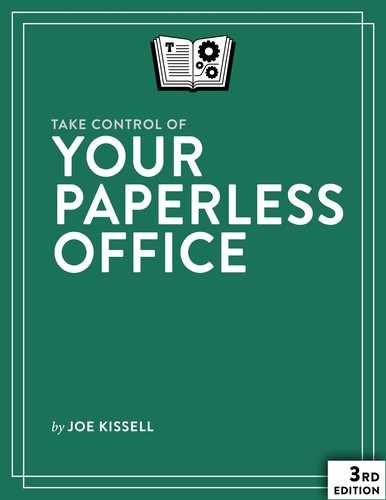Introduction
My feelings about paper might best be described as ambivalent. As I write these words, I’m sitting in a library surrounded by books of the old-fashioned paper kind. I’ve written several such books myself, and I’ve often formed opinions about people based on how many books (and which ones) are in their homes. Had paper not been invented, I imagine many other characteristics of modern life as we know it would never have developed. Paper facilitated the recording of history, the dissemination of knowledge, the spread of literacy, and a great many other worthwhile things that I’m grateful for.
On the other hand, I’ve also written dozens of ebooks like the one you’re now reading, and have shifted most of my professional and recreational reading to books in digital formats—an activity made considerably more enjoyable by the Retina displays on my iPad, iPhone, and MacBook Pro. I like the fact that I can search, annotate, and back up my books now, and that I can accumulate as many as I want without running out of shelf space, as often occurs in my home.
But I truly lose all tolerance for paper when it comes to office paperwork—letters, forms, invoices, bank statements, receipts, business cards, flyers, note cards, catalogs, handouts from meetings and trade shows, photocopies of library book pages, and anything else that might end up on my desk in printed form. I used to have several filing cabinets full of the stuff, and overflowing—and yet, despite what I thought was an intelligent filing system, it frequently took me a long time to find what I was looking for. And because every day more paper would appear (some of it coming from my own printer), it was difficult to keep on top of it. The clutter became unmanageable, and I found that I spent far too much of my time managing paper rather than accomplishing useful tasks.
Never is the scourge of paper clutter more apparent than when I move, which I tend to do every few years or so. I get tired just looking at all those paper files, and I find myself cursing all those paper books that I love to surround myself with, because they’re so heavy and bulky. But most of my struggle with paper, I’m happy to say, is in the past. For several years now I’ve been moving toward a paperless office. I now receive, and generate, only a tiny fraction of the paper I once did. And virtually every paper document that comes into my life is scanned, converted to a searchable format, and digitally archived—so I can find nearly any document I need with a few keystrokes. And, because everything is backed up, I don’t worry about my papers being wiped out by a fire or other catastrophe.
In this book, I explain how to do what I do when it comes to paper. By examining where and how you use paper and looking for suitable digital alternatives, you’ll find that your productivity and happiness increase, while clutter and stress decrease. You might even save some money and benefit the environment.
What I describe is a multi-pronged approach to eliminating paper. Of course, even if you avoid generating your own paper clutter and reduce the paper other people send you, some paper will still find its way to you—and you may have many thousands of pages already. So one of the central features of the plan I discuss is scanning paper documents and processing them in a way that retains their physical appearance while letting you index, search, select, and copy their text. I also talk about using devices such as the iPad, iPhone, and Kindle (and even digital cameras) to maximum advantage—and doing clever things you may never have thought of, like paperless postal mail and fax.
Let me be clear, though: I’m not going to tell you to get rid of all your paper, or that resorting to paper for any reason is somehow a moral failure. Paper has many noble uses, and I wouldn’t pretend otherwise. You may choose to adopt all my recommendations, or only a few—everyone’s different, so by all means, do only what works for you.
The plan I cover is appropriate for a home office or small business. If you aspire to take a large corporation paperless, I applaud you—but that sort of project is beyond the scope of this ebook.
I also assume that you have at least one Mac at your disposal. While everything I discuss can be accomplished in a comparable fashion with other operating systems, in this ebook I focus on Mac-compatible hardware and software. Unless otherwise noted, everything in this book should work with 10.9 Mavericks or later. Although much of this material also applies to earlier versions of Mac OS X, I don’t call out any specific issues or differences.
